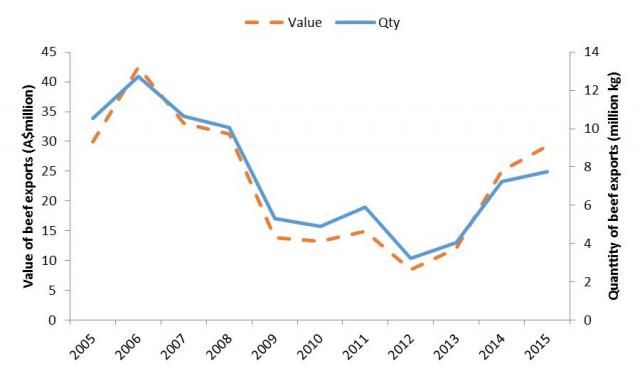Market analysis - Korea
In 2015 Korea was Western Australia’s largest market for boxed beef by volume, accounting for 18% of the market or 7.8 million kilograms, an increase of 7% year on year (Figure 8). Korea was the second largest market in value terms, worth $29.2 million during 2015, an increase of 17% year on year (Figure 10).
Between 2012 and 2015 there has been remarkable growth in beef exports to Korea, both in value and volume, as seen below in Figure 21. In that period there has been a 141% increase in volume from 3.2 million kilograms to 7.8 million kilograms, and a 244% increase in value from $8.5 million to $29.2 million.

The Korea-Australia Free Trade Agreement (KAFTA), which came into force in December 2014, will see the then 40% beef tariff and 18% beef offal tariff on Australian exports eliminated by 2028. Australia is already benefiting, with the tariff down to 32% for beef exports in 2016. Korea also has a quota system in place for beef imports, which in 2016 is 160 829 tonnes. Once the quota is met, the tariff returns to 40% (MLA).
Key competitors on the Korean beef market are the USA, New Zealand and the local Hanwoo beef. Domestic beef accounted for almost half the market in 2014 (MLA), based on the popularity of the indigenous Hanwoo, which was originally a draught animal and has the same origins as the Wagyu. Hanwoo cattle have high fertility rates, but slow growth and low milk yields. Hanwoo is the preferred source of beef as it is considered to be fresher and more flavoursome (Wagyu International).
In 2003 the USA, which was a major supplier of beef to Korea, suffered a bovine spongiform encephalopathy (BSE) outbreak. In response to the outbreak, Korea suspended beef imports from the USA and total beef consumption was reduced due to health concerns. In 2007, beef from the USA re-entered the market, which may have contributed to the decrease in WA exports to Korea at this time (Figure 21) (MLA).
The majority of cuts exported from WA to Korea are bone-out and frozen, however some fresh cuts are also exported.
As illustrated in Figure 22, the most popular beef cuts exported to Korea are bone-out chuck roll and brisket and bone-in ribs. There has been substantial growth between 2014 and 2015 in the export of bone-in ribs (30%), bone-out blade (280%), bone-out brisket (135%), bone-out chuck roll (21%) and bone-out thick flank/knuckle (214%) (based on MLA data, DAFWA analysis). Manufacturing beef seems to be losing popularity, as there has been a 45% fall in volume exported year on year and bone-in blade has decreased 91% year on year.
In 2015 the Korean population was estimated to be approximately 50 million and beef consumption was approximately 11 kilograms per capita per year (MLA).
The Korean national cattle herd (including dairy cattle) peaked in 2012 at 3.5 million head but was down to 3 million in March 2016 (Statistics Korea).
The number of Korean cattle farms has been in a state of decline over the last 30 years. About 17% of the national cattle herd comes from cattle farms that have less than 20 head, and these small farms comprise more than 65% of cattle farms in Korea. The proportion of larger farms has been increasing over recent years and as of 2014, a third of cattle were contained on farms with over 100 head (MLA).

